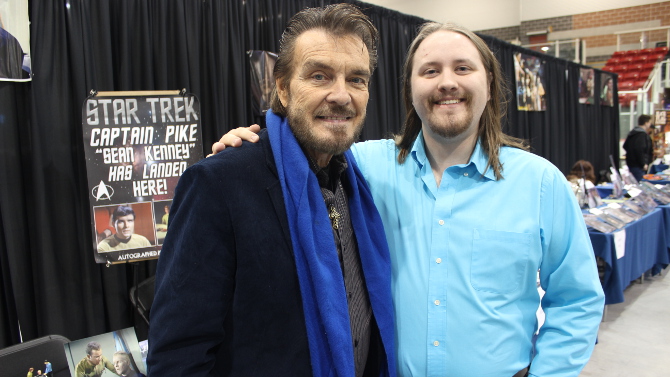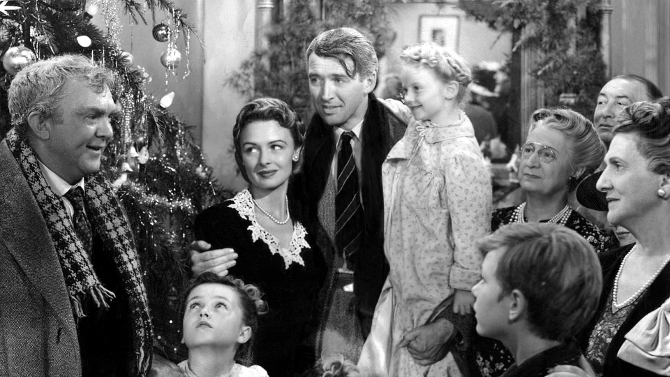It is hard to fathom that Frank Capra’s classic feature It’s a Wonderful Life turns 70 this year (on December 20th to be exact). A movie of vital importance to millions of people the world over, it has not only become a Christmas staple, but also a yuletide tradition for many a family, though this was not always the case. Getting off to a more than sluggish start (losing major money at the box office), it was not originally a hit (or believed by most critics that it would ever leave an impactful mark on the spools of film history).
In a miracle befitting of the fantasy drama, the tides for the downtrodden film turned around in the 1970s (thanks to a fortunate copyright lapse), finding a more than accepting audience on the television screen. Taking off, it has gained the traction director Capra once had hoped for, for his story – though he never truly expected it to get a second chance. He actually said (to The Wall Street Journal in 1984): “It’s the damnedest thing I’ve ever seen. . .The film has a life of its own now and I can look at it like I had nothing to do with it. I’m like a parent whose kid grows up to be President. I’m proud. . . but it’s the kid who did the work. I didn’t even think of it as a Christmas story when I first ran across it. I just liked the idea.”
At the second Cornwall and Area Pop Expo (CAPE), I was lucky enough to interview Sean Kenney. Perhaps best known for his memorable role as Captain Pike in the original Star Trek series, the actor intriguingly spent most of his time in the 1970s working on low budget exploitation pictures: The Corpse Grinders, The Toy Box, Cycle Psycho and Terminal Island – these titles should give you an idea of the vein of the movies he starred in. Having lived a truly interesting life in film, make sure to check out his interview below to hear all kinds of wonderful stories about his time in the industry. I use the word ‘wonderful’ as It’s a Wonderful Life is his favourite film. Also make sure to listen to the second interview at the bottom of the page to hear two superb stories that found him meeting with legendary directors Frank Capra and François Truffaut.
Made by Capra with a view “to combat a modern trend toward atheism”, the story follows George Bailey (Jimmy Stewart – the perfect everyman), a distraught man, on Christmas Eve. Like some sort of supernal lifeline, Heaven hears his pained prayer. His guardian angel, Clarence (Henry Travers), is prepared for what he is about to encounter. The celestial being (who is still struggling to earn his wings) is shown the life of the man he is going to assist.
Learning about the good man and the factors that have led to his crisis, we see: how he rescued his brother Harry when he fell into a half-frozen pond (George lost his hearing in one ear due to his heroics); saved his employer, Mr. Gower (H.B. Warner), from making an egregious mistake; as well as how he marries the love of his life, Mary (Donna Reed), and is forced, by circumstances, to stay in the town of Bedford Falls – running the family business of Bailey Brothers’ Building and Loan, much against his wishes.
This infuriates Henry F. Potter (Lionel Barrymore), the richest and least gracious man in town. Bailey further complicates the situation by infringing on Potter’s control of the housing market, making it easy for people to purchase their own homes instead of renting the Scrooge-like man’s slums. When the opportunity arises for Potter to crush his competition, he does so with great zest.
With a failing business and no hope in sight, the inebriated George contemplates committing suicide, but his guardian angel intervenes (bringing us back to the present). Deciding that it might have been better if he hadn’t existed, the acquiescing Clarence shows him an alternate time line in which he was never born. Seeing how life would change (for those in his life) if he had never existed, will George Bailey realize that his seemingly insignificant life has importance, or will he continue to wallow in his quagmire of despair?
Fusing drama, emotional heft and comedy together in perfect doses (unlike the drug store owner, Mr. Gower), this is once again a perfect example of why this director’s films have been nicknamed ‘Capracorn’ – which I see as a highly positive term. Able to tug at your heartstrings at one moment and then bring a smile to your face the very next, Capra called this the favourite film that he ever made (similarly, Stewart and Reed also claimed the same thing). Though the movie works miraculously as a whole, there are so many small moments that help build to the emotional finale. As mentioned above, the drug store scene is always referenced as a tear jerker moment, while the swimming pool scene is just one example of jollity that the picture brings – a nice piece of trivia finds the boy behind the prank being played by Carl Switzer, Alfalfa of The Little Rascals fame. Then, there is the utterly romantic ‘Lasso the Moon’ scene, where George woos Mary. These, along with so many other moments, make us, the viewers, all the richer in spirit.
Though, none of this would hit quite right if it was not for the perfect casting. You could not ask for a better person to relate to than Jimmy Stewart – always able to portray a kindly, caring, big hearted man, but is equally as good at playing downtrodden (thankfully, he starred in this motion picture instead of the originally planned Cary Grant). Those of you who have seen the film will undoubtably recall ‘the prayer scene’. A superb film making story is when Stewart nails it on his first take, catching the usually prepared Capra off-guard (perhaps because he was in tears watching the actor at his best). Discovering that he missed the shot, he never achieved a close-up of the wrought emotion etched over the man’s anguished visage. Stewart, knowing that he could do no better (and feeling the emotional toll from the first take), told the director so. Luckily, in post production, Capra and editor William Hornbeck were able to manually edit the shot, making it feel like a slow optical zoom (achieving perfection by way of a disastrous mistake). Another error that works finds Uncle Billy (Thomas Mitchell) stumbling out of view after a few too many, where, off camera, it sounds like he tumbles into some trash cans. It was actually a crew member dropping something, but as Stewart began laughing, Mitchell quickly improvised “I’m alright, I’m okay!”, adding a nice touch to the sequence (thus, making it into the film).
Then, there is the brilliant performance from Reed (a captivating wife to play off of Stewart, feeling like a match actually made in Heaven). It was her first starring role and she is utterly luminous. To those of you who have been impressed by Beulah Bondi’s take as Stewart’s mother, it may be because she previously played that role in three earlier films, including Mr. Smith Goes to Washington (another Capra feature). Of course, each actor is superlative, but I would like to conclude with Barrymore, a supreme example of how a villain does not need superpowers or over-the-top gadgets to be menacing and overtly intimidating.
One of the most inspirational and moving movies to come out of the United States, It’s a Wonderful Life has left an indelible mark on seventy years worth of people. A cinematic tour de force from all of its moving parts, it is definitely worth a viewing this Christmas season. So, let this review ring a bell of reminder in your mind to watch this holiday classic where you’ll discover why it is one of the greatest gifts of all time.


